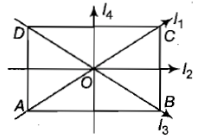A pan containing a layer of uniform thickness of ice is placed on a circular turntable with its centre coinciding with the centre of the turn table. The turntable is now rotated at a constant angular velocity about a vertical axis passing through its centre and then driving is withdrawn. There is no friction between the table. As the ice melts
1. the angular velocity of the system decreases
2. the angular velocity of the system increases
3. the angular velocity of the system remains unchanged
4. the moment of inertia of the system decreases
The motion of planets in the solar system is an example of the conservation of
1. mass
2. Linear momentum
3. Angular momentum
4. Energy
Two Circular discs A and B are of equal masses and thicknesses but made of metal with densities (). If their moments of inertia about an axis passing through their centers and perpendicular to circular faces be , then
1.
2.
3.
4.
A body is rolling without slipping on a horizontal surface and its rotational kinetic energy is equal to the translational kinetic energy. The body is
1. Disc
2. Sphere
3. Cylinder
4. Ring
A wheel with a radius of \(20\) cm has forces applied to it as shown in the figure. The torque produced by the forces of \(4\) N at \(A\), \(8~\)N at \(B\), \(6\) N at \(C\), and \(9~\)N at \(D\), at the angles indicated, is:
1. \(5.4\) N-m anticlockwise
2. \(1.80\) N-m clockwise
3. \(2.0\) N-m clockwise
4. \(3.6\) N-m clockwise
The moment of inertia of a thin rectangular plate \(\text {ABCD}\) of uniform thickness about an axis passing through the centre \(\text O\) and perpendicular to the plane of the plate is


1. \(\text I_{1} + \text I_{2}\)
2. \(\text I_{2} + \text I_{4}\)
3. \(\text I_{1} - \text I_{3}\)
4. \(\text I_{1} +\text I_{2 } + \text I_{3} + \text I_{4}\)
The centre of a wheel rolling on a plane surface moves with a speed \(v_0.\) A particle on the rim of the wheel at the same level as the centre will be moving at speed:
1. zero
2. \(v_0\)
3. \(\sqrt{2}v_0\)
4. \(2v_0\)
Moment of inertia of a uniform cylinder of mass M, radius R and length l about an axis passing through its center and normal to its axis would be
1.
2.
3.
4.
A particle moves along a circle of radius with constant tangential acceleration. If the velocity of the particle is 80 m/s at the end of the second revolution after motion has begin, the tangential acceleration is
1. 640
2. 160
3. 40
4. 40
If the radius of the earth is suddenly contracted to half of its present value, then the duration of the day will be of:
| 1. | 6 hours | 2. | 12 hours |
| 3. | 18 hours | 4. | 24 hours |







